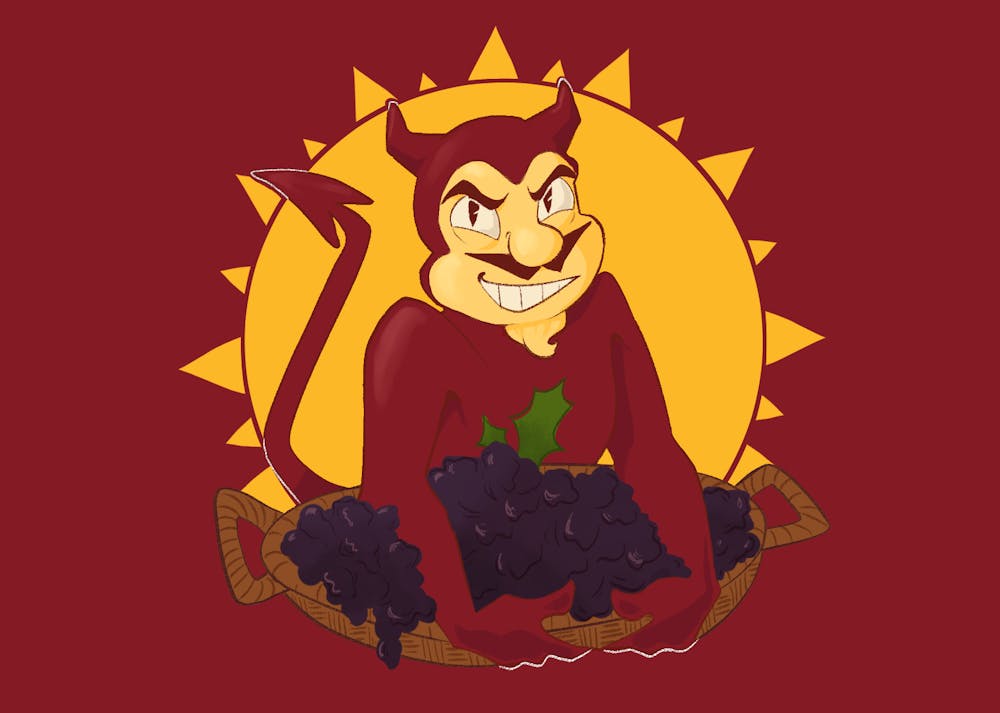The ASU Tempe campus is a designated arboretum that is meant to be an oasis for plants from around the world, including the date palms that line the sidewalks on campus.
ASU is home to the largest collection of date palms of any public garden in the country, a desert plant that has certain varieties unique to Arizona.
Date palms are not native to Arizona, but their ability to survive in desert climates has allowed them to thrive in the state and created a tradition around their harvest at ASU. Date palms are part of the University’s history.
Date palms, or Phoenix dactylifera, are a species of palm trees that can grow over 80 feet tall and produce date fruit, according to the New World Encyclopedia.
Date palms were first planted at ASU around 1917 by President Arthur John Matthews, University president from 1904- to 1930. Often called the “President Gardener,” Matthews was interested in beautifying the Tempe campus.
Date palms were brought to the Tempe and Phoenix area in the late 1800s to start a commercial date palm industry, and over 300 varieties of date palms from the Middle East and North Africa were imported, which adapted well to Arizona's climate, said Ronald Palmer, a local date palm enthusiast.
"They have been grown around cities like Baghdad and Basra, which have climates very similar to the Phoenix area," said Scott Frische, a horticulturist at the Phoenix Zoo. "They are funny plants. They need warm, dry air to ripen their fruit, yet they are also a high moisture plant. So they need nice wet soil, or moist soil to grow in; you've got to give them the best of both worlds."
The date palms did well in Phoenix, but the occasional intense monsoon season would disrupt the dates and produce a bad crop some years, so the commercial date business settled in Yuma and the Coachella Valley, Frische said.
Of the original 300 date palms varieties brought to Phoenix, less than 30 remain, and all those varieties are at ASU, Palmer said. The collection is home to 140 date palm trees and over 50 varieties, including Medjool, Black Sphinx, Honey and Halaway.
Date palms are unique in the plant world because they are dioecious, meaning they are either male or female, with the males producing pollen and the females flowers. Only 6% of flowering plant species are dioecious.
They are not pollinated by bees or insects, but by wind, which means in order to produce the same varieties of dates they have to be pollinated by hand, said Deborah Thirkhill, arboretum program coordinator at ASU. If the pollen of one date palm variety pollinates another, it can create a completely new variety of date, Palmer said.
One of those dates is called the Maresco date. It was found in the backyard of the Maresco family by Richard Harris, an ASU horticulturist who collected offshoots from date palms to keep certain varieties going, said Palmer.
In the 1990s, Harris started the ASU date palm collection by asking the Department of Agriculture for offshoots and going around Phoenix looking for date palms in people’s backyards, said Frische. Frische joined Harris in gathering these date palms.
"I went out in the ASU van ... and we collected some Iteema date palm offshoots from 75th Avenue and Thunderbird from an old farm property that was about to be converted to a Safeway store," Frische said.
The collection was originally planted on a 47-acre lot off of Price Road and had over 200 trees, but the land was sold in the early 2000s and most of the date palms were moved to the Polytechnic campus, said Thirkhill.
Today, there are three acres of date palms at the Polytechnic campus where Thirkhill, students and volunteers look after, pollinate and collect the dates once they have ripened.
Sharing the dates with the ASU community is a tradition started by President Matthews, who would distribute them among faculty and staff during the 1920s and '30s, Thirkhill said.
When Thirkhill became program coordinator 15 years ago, she wanted to offer the entire ASU community to try the dates themselves.
“They gave 800 boxes to give to all the faculty and staff, and we just gave them away,” said Thirkhill. “When I came on board I asked, 'Why aren’t the students and everybody having a taste of these rare varieties of dates?' We had to jump through a lot of hoops so we were able to sell it, but now we're allowed to sell our dates.”
The dates are harvested throughout September and October and are then sold at the Zero Waste Office until December. Students can volunteer to join in on the harvest online.
Edited by Kaden Ryback, Wyatt Myskow and Kristen Apolline Castillo.
Reach the reporter at aeagerto@asu.edu and follow @audrey_eagerton on Twitter.
Like The State Press on Facebook and follow @statepress on Twitter.




